You don’t have to be an entomologist to identify different types of black and orange fuzzy caterpillars in your garden. But the surprising thing is that 99% of gardeners struggle to pinpoint this larval stage of moths and butterflies.
This article is a guide to identifying the most beautiful types of black and orange caterpillars with pictures and names. These descriptions of the larval insects and photos will help determine what butterfly or moth species they will turn into.
You May Also Like: Types of Butterfly Caterpillars with Pictures
How to Identify Black and Orange Caterpillars
Black and orange caterpillars are the larval stage of moths and butterflies. These creatures have a fat worm-like body with black and orange stripes. The furry orange bodies with black bands also have tufts of spiny hairs sticking out.
You can identify black and orange caterpillars from the worm-like body with bristles, stumpy-looking prolegs, head shape, and six legs. But there are some scary-looking black and orange fuzzy caterpillars with black spikes on their back and heads.
These caterpillar types eat specific plants and go through several instars. A juvenile caterpillar looks different from a mature caterpillar about to enter the pupa stage. For instance, a juvenile mourning cloak caterpillar may appear as a stinging caterpillar despite being harmless.
Some orange and black fuzzy caterpillars are poisonous to some animals since they feed on ragwort and store the poison in their bodies. If small rodents or birds consume these caterpillars in large amounts, the poison will be fatal.
Most black and orange grubs measure less than an inch to six inches long. Besides that, they belong to the order Lepidoptera. There are over 180,000 caterpillar species that turn into different types of moths or beautify butterflies.
Different Types of Black and Orange Caterpillars
Let’s look into this black and yellow fuzzy caterpillar identification guide for more insights. I have also shared a quick black caterpillar identification chart for finer details at the end.
Redhumped Moth Caterpillar (Schizura concinna)
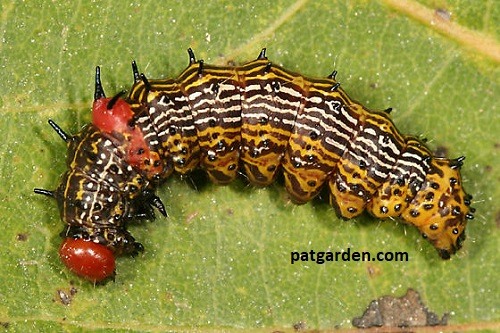
The grub has an identifiable redhead, reddish hump, black spikes, and yellow-orange body with stripes. Mature striped caterpillars develop a yellowish-orange body with black and white stripes.
Red-humped moth caterpillars can grow up to two inches long and feed in clusters. These long grubs can defoliate fruit trees, walnut trees, willow trees, and cottonwood trees.
These caterpillars hail from southern Canada, Florida, California, and Asia. They undergo metamorphosis during spring into pupae and later adult moths.
Cinnabar Moth Caterpillar (Tyria jacobaeae)
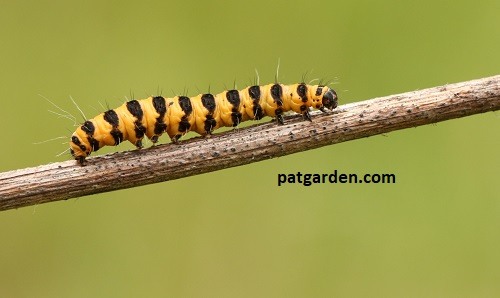
A cinnabar moth caterpillar has orange and black bands around the body with long feathery spines. It also has three pairs of black legs at the front section of the body.
Four pair of black and orange prolegs occurs at the middle section of its body. A mature cinnabar caterpillar can reach 1.2 inches long.
These grubs are poisonous to predators feeding on them since they eat ragwort. The voracious appetite makes these caterpillars destructive since they can strip the plant of its leaves.
Cinnabar moth caterpillars are native to Europe and Asia (Siberia and China). The caterpillars have been introduced in New Zealand, Australia, and North America to control ragwort.
Yellow Tail Moth Caterpillar (Sprageidus similis)
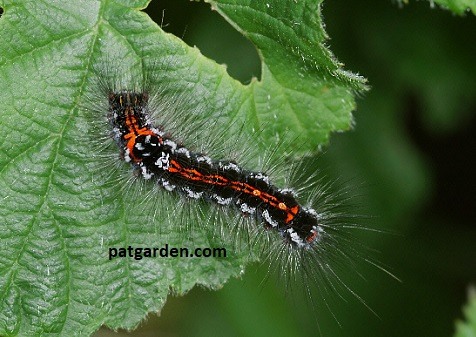
A yellowtail moth caterpillar has black, orange, and white bands running lengthwise with black and white long spines.
It also has orange-red bumps on the head and white patches on segments. These menace-looking caterpillars later turn in flying white moths with yellow-tail.
A mature yellowtail moth caterpillar can reach 1.2 inches long. These grubs love feeding on fruit tree foliages, birch tree leaves, oak leaves, hawthorn leaves, and rowan leaves.
The caterpillar species hail from Southern India, Sri Lanka, Siberia, and Europe. The spikes are poisonous and can cause skin allergic reactions.
Isabella Tiger Moth Caterpillar (Pyrrharctia isabella)
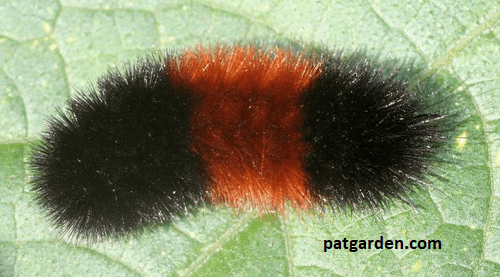
An Isabella tiger moth caterpillar has a tuft of short black or reddish-orange hair covering its body. The wide rusty-orange band around its middle and fuzzy black ends make it unique.
Other distinguishing features are the orange forelegs, small head, black and orange look. It is also called a woolly bear caterpillar and can reach 2.4 inches long.
The black and orange woolly bear caterpillar turns into a spectacular yellow moth. Other common names are black-ended bear caterpillar, woolly worm, and banded woolly bear caterpillar.
The woolly bear caterpillars are native to the United States and Southern Canada. They thrive in the spring season and enter the pupal stage in early summer.
Garden Tiger Moth Caterpillar (Arctia caja)
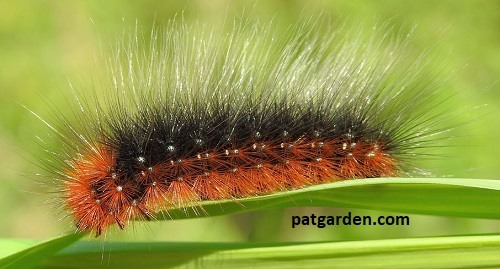
A woolly garden tiger moth caterpillar has a black hairy appearance with orange coloring along its sides. The spiny hairs can cause skin irritation if handled without gloves.
The large garden tiger moth caterpillar can reach 2.4 inches long. These grubs usually transform into striking brown and white moths with leopard patterns on their wings.
The woolly bear caterpillars are northern species from the United States, Canada, and Europe. They feed on specific plants and love cold climate conditions.
Gulf Fritillary or Passion Butterfly Caterpillar (Agraulis vanilae)
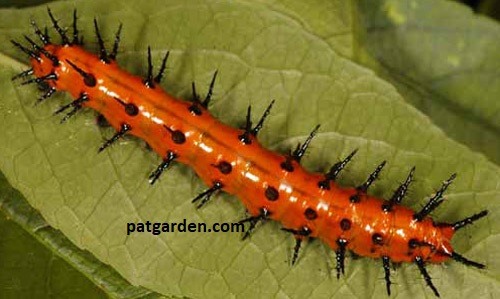
The grub has a smooth orange and black or gray body covered with shiny black spines. It can grow up to half an inch to become a dark rusty orange caterpillar.
These caterpillars feed on leaves of plants belonging to the Passifloraceae family. It is the reason behind the name passion butterfly caterpillar.
The caterpillar species hail from the United States of America. A mature butterfly has long and narrower wings than other species.
Spiny Oakworm Caterpillar (Anisota stigma)
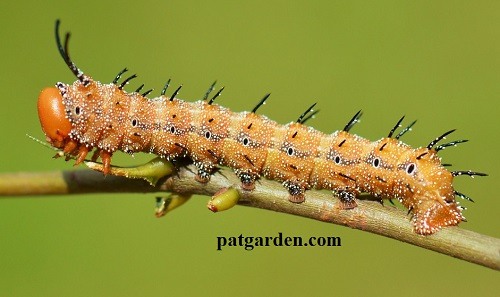
An orange spiny oak worm is covered with tiny white dots and black spines. The black curved horn on its head is another distinguishing feature.
These grubs are solitary and feed on oak leaves during late July. These oak worm caterpillars later turn into striking furry orange and pink moths.
Spiny oak worm caterpillars are native to North American states like Florida, Ontario, Texas, Kansa, and Minnesota.
Rusty Tussock Caterpillar (Orgyia antiqua)
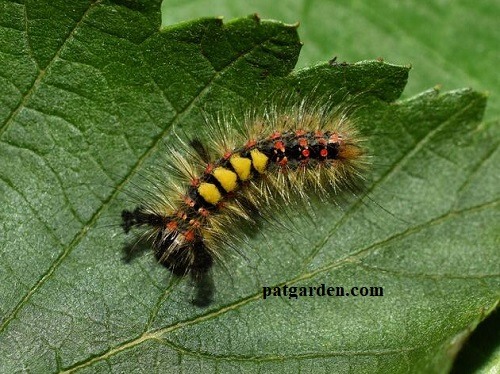
These grubs have horns, humps, and a tail. They are also covered in black, yellow, orange, and white irritating bristle-like hairs with four clumps of hairs on their back.
The orange-red tubercles along its backs and sides are crucial in identifying this black and yellow fuzzy caterpillar. It can reach 3-4 cm long.
The caterpillar species hails from Europe and feeds on a wide range of deciduous trees and shrubs. It is among the black and orange caterpillar poisonous category.
Fox Moth Caterpillar (Macrothylacia rubi)
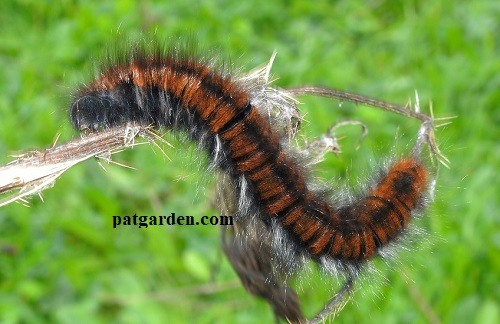
The grub has a hairy black body with bright yellow oranges running along its back. It can reach 8 cm and turn into an attractive tan-colored furry moth with a large body.
Fox moth caterpillars feed on birch trees, willow trees, small shrubs, and flowering perennial plants in the legume family. These species are native to West Europe, Central Asia, and Siberia.
Oleander Caterpillar (Syntomeida epilais)
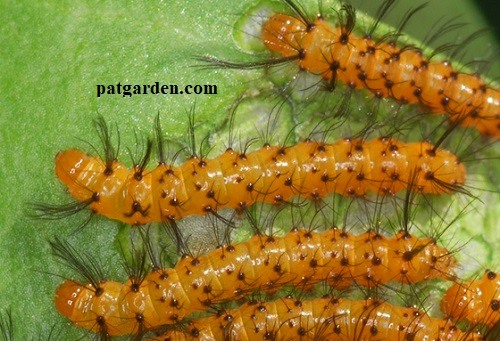
An oleander caterpillar has a bright orange body with black tubercles growing long black hairs. It is spiky and safe to touch. The grub can reach 1.5 inches long at maturity.
The caterpillar species has a voracious appetite and feeds on foliages from oleander or desert rose plants. Thes polka-dot wasp moth larvae turn into a blue moth with iridescent coloring.
Oleander caterpillar species are native to southern Florida and Georgia. They can also destroy your ornamental houseplants.
Drinker Moth Caterpillar (Euthrix potatoria)
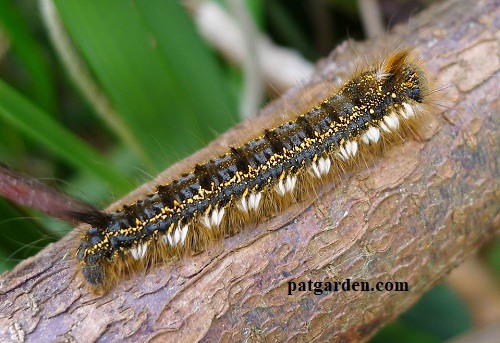
Drinker moth caterpillar has orange hair tufts with black and orange bands running lengthwise on its back. The grub also has a unique round head and can grow up to 2.4 inches long.
The moth caterpillar has four hairy orange prolegs on the middle segment. A mature grub turns into a furry orange moth.
These moth caterpillars are popular in Europe and Britain. They prefer marshy places, fens, grassy terrains, and riversides.
Cape Lappet Moth Caterpillar (Eutricha capensis)
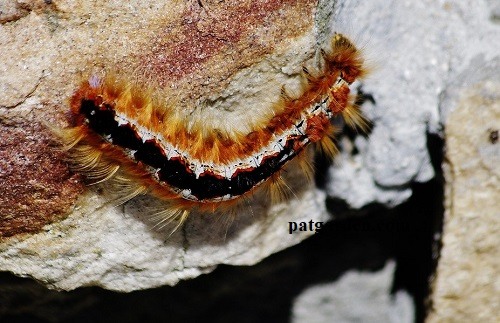
The cape lappet moth caterpillar has bright orange tufts of hair on both sides with a black and white back. It also has coppery-orange hair tufts on the head.
The moth caterpillar can grow up to 2.4 inches long. The caterpillar species love feeding on a wide range of African plants in the garden.
Imperial Moth Caterpillar (Eacles imperialis)
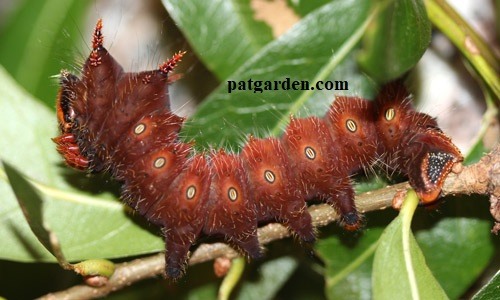
The imperial moth caterpillar has four large and spiny black horns on the head. The body is covered with several short spikes and hairs.
The spiky caterpillar has yellow coloration with black stripes. These grubs turn to rusty red or orange with spiny hairs at a certain age.
These intimidating caterpillars can be brown, maroon, or green. They hail from New England, Southern Canada, and Florida.
Mourning Cloak Caterpillar (Nymphalis antiopa)
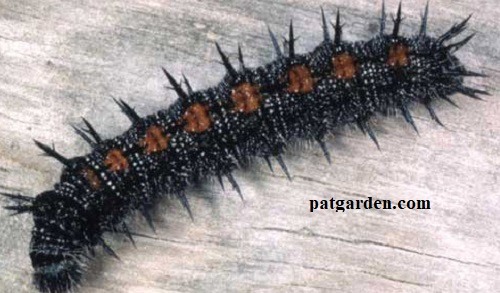
A mourning cloak caterpillar has a black body with orange dots on its segment. The body has white hairs with softback spots.
The caterpillar can grow up to two inches long. The mourning cloak butterfly caterpillars are native to Eurasia and North America.
Spurge Hawk-Moth Caterpillar (Hyles euphorbiae)
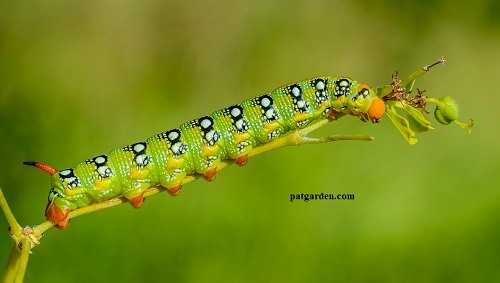
A spurge hawk-moth caterpillar has a smooth black and orange body with dots. It also has an orange head, legs, and prolegs.
The yellow abdomen and a band of white dots are other crucial features for identifying the spurge hawk-moth caterpillar. They can grow up to four inches long.
These grubs feed on sea spurge plants with other agents. These caterpillar species hail from Europe and the United States of America.
Milkweed Tiger Moth Caterpillar (Euchaetes egle)

A milkweed tiger moth caterpillar has black hair tufts with orange clumps of hairs on its back. Some tufts may be grayish or whitish since it depends on the caterpillar species.
This orange and black fuzzy caterpillar can grow up to 1.4 inches long. These grubs love feeding on dogbane and milkweed plants.
Tetrio Sphinx Caterpillar (Pseudosphinx)
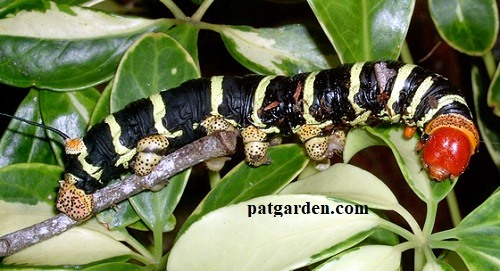
A tetrio sphinx caterpillar has a jet black body with orange legs, head, and tail. The yellow bands help separate the segments and grow up to six inches.
These rasta caterpillars are native to the southwest United States of America and Brazil. Caterpillar hairs can cause skin irritation.
Old World Swallowtail Caterpillar (Papilio machaon)
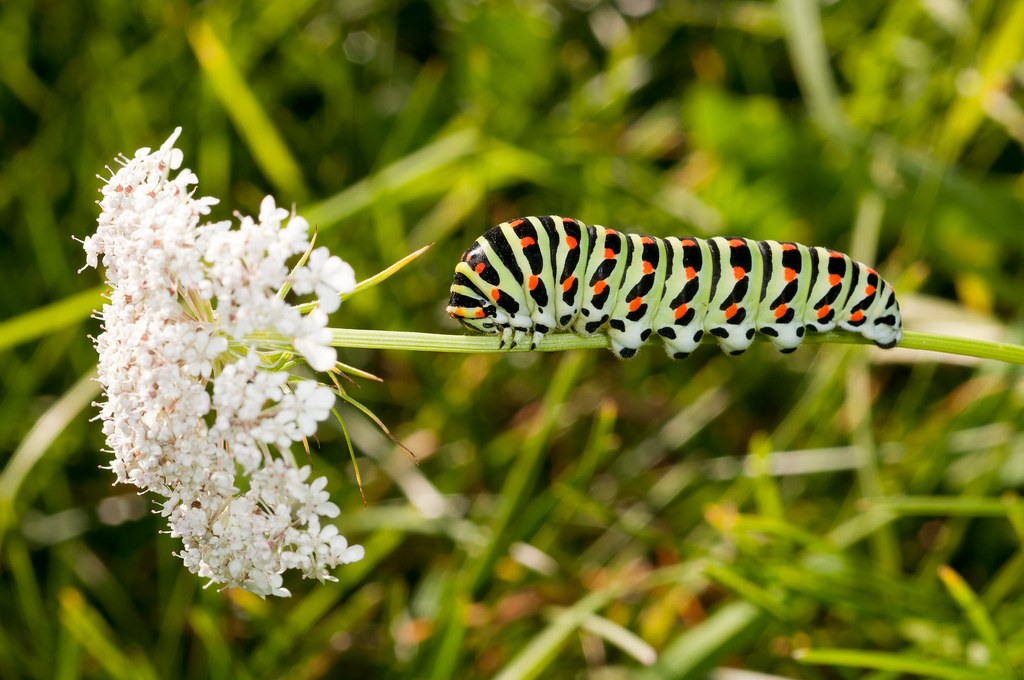
An old-world swallowtail caterpillar is a type of green caterpillar thought it has orange and black bands around its segments. The fat caterpillar can grow up to 1.8 inches long.
The grub turns into a striking swallowtail butterfly with creamy white and black wings. The blue and red markings make the butterfly stand out.
The bright green body with black and orange markings is an essential feature for identifying this butterfly caterpillar. These grubs raise the front section when they feel threatened.
Regal Moth Caterpillar (Citheronia regalis)
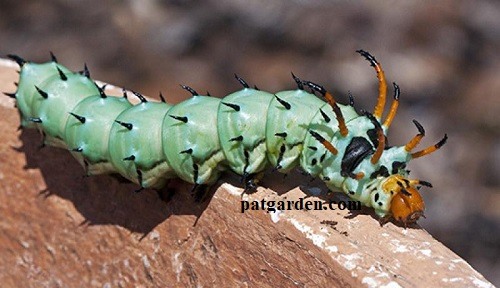
A regal moth caterpillar has a bright green body with pricky orange and black horns. The small black spikes on the body are harmless and ideal for defense mechanisms.
This huge horned caterpillar is also called a hickory horned devil, and it is the largest insect in the world and measures about six inches long. It hails from North America and Canada.
Frequently Asked Questions
Are Black and Orange Caterpillars Poisonous?
No. Most black and orange caterpillars are non-poisonous and safe to touch. But I recommend wearing protective gloves when handling any caterpillar species.
What Do Black and Orange Caterpillars Eat?
These caterpillars are herbivores since they feed on wildflowers, clovers, dandelions, and many other plants. Some species prefer munching leaves of maple and birch trees.
Are Tiger Moth Caterpillars Poisonous?
No. But the spiky hairs can irritate the skin after touching. It is a defense mechanism for tiger moth caterpillars against their predators.
Final Word
Black and orange caterpillars are the larval stage of moths and butterflies. The black caterpillar with orange stripes can be scary and intimidating due to the black spikes on their heads and back.
I hope this article guide will help you distinguish black and orange caterpillars from all black caterpillars. Feel free to share this black caterpillar identification guide with your loved ones.
You May Also Like: